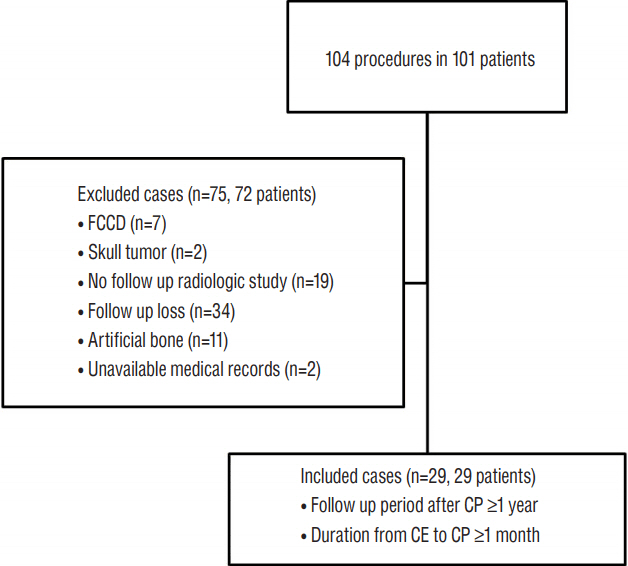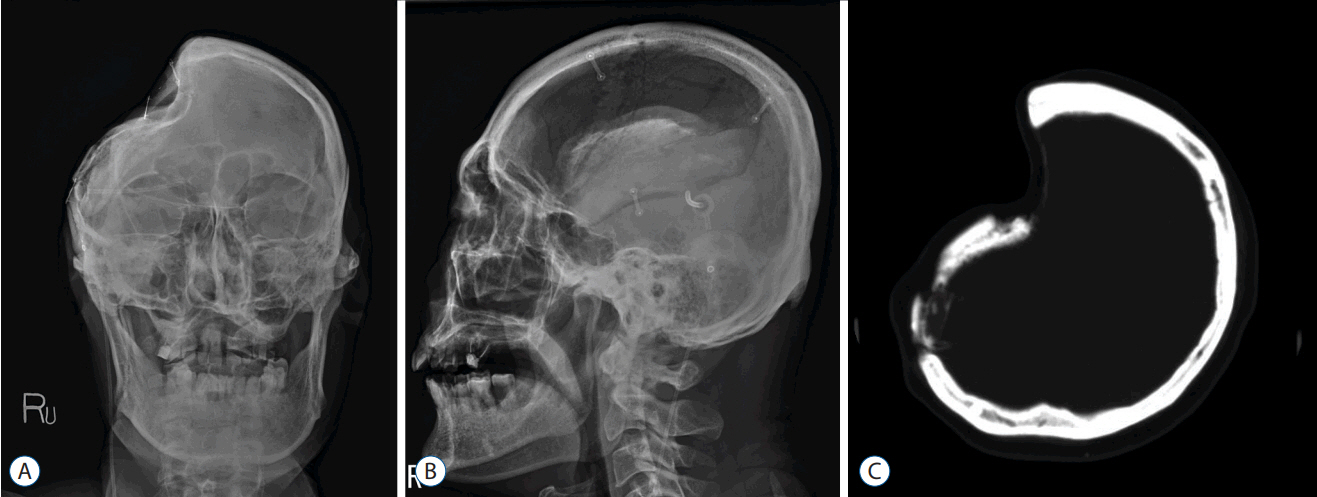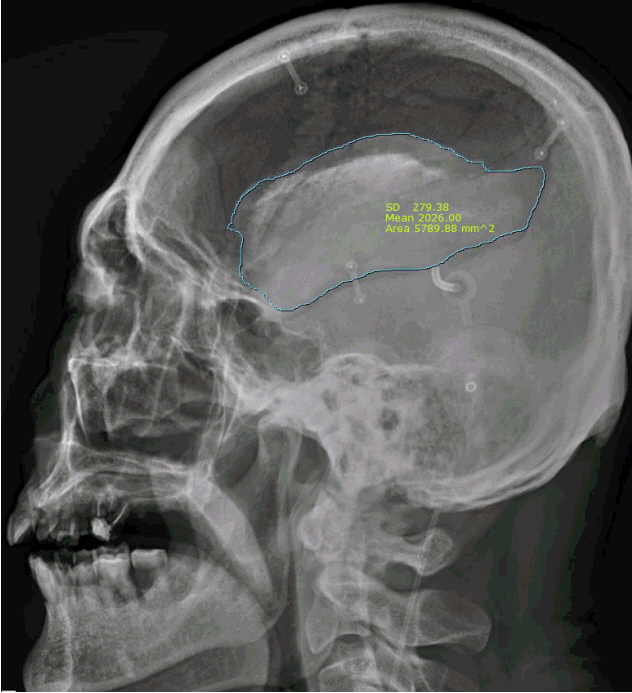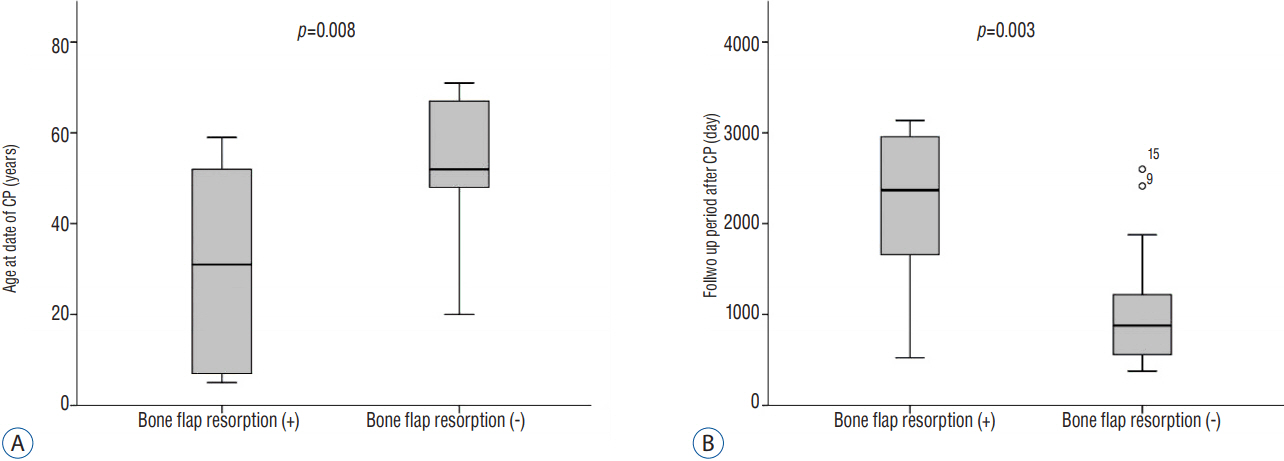J Korean Neurosurg Soc.
2017 Nov;60(6):749-754. 10.3340/jkns.2017.0203.002.
Bone Flap Resorption Following Cranioplasty with Autologous Bone: Quantitative Measurement of Bone Flap Resorption and Predictive Factors
- Affiliations
-
- 1Department of Neurosurgery, Eulji University Eulji Hospital, Seoul, Korea. grimi2@hanmail.net
- KMID: 2395796
- DOI: http://doi.org/10.3340/jkns.2017.0203.002
Abstract
OBJECTIVE
To quantitatively measure the degree of bone flap resorption (BFR) following autologous bone cranioplasty and to investigate factors associated with BFR.
METHODS
We retrospectively reviewed 29 patients who underwent decompressive craniectomy and subsequent autologous bone cranioplasty between April 2005 and October 2014. BFR was defined as: 1) decrement ratio ([the ratio of initial BF size/craniectomy size]-[the ratio of last BF/craniectomy size]) >0.1; and 2) bone flap thinning or geometrical irregularity of bone flap shape on computed tomographic scan or skull plain X-ray. The minimal interval between craniectomy and cranioplasty was one month and the minimal follow-up period was one year. Clinical factors were compared between the BFR and no-BFR groups.
RESULTS
The time interval between craniectomy and cranioplasty was 175.7±258.2 days and the mean period of follow up was 1364±886.8 days. Among the 29 patients (mean age 48.1 years, male: female ratio 20: 9), BFR occurred in 8 patients (27.6%). In one patient, removal of the bone flap was carried out due to severe BFR. The overall rate of BFR was 0.10±0.11 over 3.7 years. Following univariate analysis, younger age (30.5±23.2 vs. 54.9±13.4) and longer follow-up period (2204.5±897.3 vs. 1044.1±655.1) were significantly associated with BFR (p=0.008 and 0.003, respectively).
CONCLUSION
The degree of BFR following autologous bone cranioplasty was 2.7%/year and was associated with younger age and longer follow-up period.
Keyword
MeSH Terms
Figure
Cited by 1 articles
-
Risk Factor Analysis of Cryopreserved Autologous Bone Flap Resorption in Adult Patients Undergoing Cranioplasty with Volumetry Measurement Using Conventional Statistics and Machine-Learning Technique
Yohan Son, Jaewoo Chung
J Korean Neurosurg Soc. 2024;67(1):103-114. doi: 10.3340/jkns.2023.0143.
Reference
-
References
1. Bobinski L, Koskinen LO, Lindvall P. Complications following cranioplasty using autologous bone or polymethylmethacrylate--retrospective experience from a single center. Clin Neurol Neurosurg. 115:1788–1791. 2013.
Article2. Bowers CA, Riva-Cambrin J, Hertzler DA 2nd, Walker ML. Risk factors and rates of bone flap resorption in pediatric patients after decompressive craniectomy for traumatic brain injury. J Neurosurg Pediatr. 11:526–532. 2013.
Article3. Brommeland T, Rydning PN, Pripp AH, Helseth E. Cranioplasty complications and risk factors associated with bone flap resorption. Scand J Trauma Resusc Emerg Med. 23:75. 2015.
Article4. Chang V, Hartzfeld P, Langlois M, Mahmood A, Seyfried D. Outcomes of cranial repair after craniectomy. J Neurosurg. 112:1120–1124. 2010.
Article5. Cheng CH, Lee HC, Chen CC, Cho DY, Lin HL. Cryopreservation versus subcutaneous preservation of autologous bone flaps for cranioplasty: comparison of the surgical site infection and bone resorption rates. Clin Neurol Neurosurg. 124:85–89. 2014.
Article6. Daou B, Zanaty M, Chalouhi N, Dalyai R, Jabbour P, Yang S, et al. Low incidence of bone flap resorption after native bone cranioplasty in adults. World Neurosurg. 92:89–94. 2016.
Article7. Dünisch P, Walter J, Sakr Y, Kalff R, Waschke A, Ewald C. Risk factors of aseptic bone resorption: a study after autologous bone flap reinsertion due to decompressive craniectomy. J Neurosurg. 118:1141–1147. 2013.
Article8. Finkemeier CG. Bone-grafting and bone-graft substitutes. J Bone Joint Surg Am. 84-A:454–464. 2002.
Article9. Gooch MR, Gin GE, Kenning TJ, German JW. Complications of cranioplasty following decompressive craniectomy: analysis of 62 cases. Neurosurg Focus. 26:E9. 2009.
Article10. Grant GA, Jolley M, Ellenbogen RG, Roberts TS, Gruss JR, Loeser JD. Failure of autologous bone-assisted cranioplasty following decompressive craniectomy in children and adolescents. J Neurosurg. 100(2 Suppl Pediatrics):163–168. 2004.
Article11. Honeybul S, Janzen C, Kruger K, Ho KM. The impact of cranioplasty on neurological function. Br J Neurosurg. 27:636–641. 2013.
Article12. Honeybul S, Morrison DA, Ho KM, Lind CR, Geelhoed E. A randomized controlled trial comparing autologous cranioplasty with custom-made titanium cranioplasty. J Neurosurg. 126:81–90. 2017.
Article13. Im SH, Jang DK, Han YM, Kim JT, Chung DS, Park YS. Long-term incidence and predictive factors of cranioplasty infection after decompressive craniectomy. J Korean Neurosurg Soc. 52:396–403. 2012.
Article14. Iwama T, Yamada J, Imai S, Shinoda J, Funakoshi T, Sakai N. The use of frozen autogenous bone flaps in delayed cranioplasty revisited. Neurosurgery. 52:591–596. 2003.
Article15. Martin KD, Franz B, Kirsch M, Polanski W, von der Hagen M, Schackert G, et al. Autologous bone flap cranioplasty following decompressive craniectomy is combined with a high complication rate in pediatric traumatic brain injury patients. Acta Neurochir (Wien). 156:813–824. 2014.
Article16. Piedra MP, Thompson EM, Selden NR, Ragel BT, Guillaume DJ. Optimal timing of autologous cranioplasty after decompressive craniectomy in children. J Neurosurg Pediatr. 10:268–272. 2012.
Article17. Rocque BG, Amancherla K, Lew SM, Lam S. Outcomes of cranioplasty following decompressive craniectomy in the pediatric population. J Neurosurg Pediatr. 12:120–125. 2013.
Article18. Schoekler B, Trummer M. Prediction parameters of bone flap resorption following cranioplasty with autologous bone. Clin Neurol Neurosurg. 120:64–67. 2014.
Article19. Schwarz F, Dünisch P, Walter J, Sakr Y, Kalff R, Ewald C. Cranioplasty after decompressive craniectomy: is there a rationale for an initial artificial bone-substitute implant? A single-center experience after 631 procedures. J Neurosurg. 124:710–715. 2016.
Article20. Shoakazemi A, Flannery T, McConell RS. Long-term outcome of subcutaneously preserved autologous cranioplasty. Neurosurgery. 65:505–510. discussion 510. 2009.
Article21. Stieglitz LH, Fung C, Murek M, Fichtner J, Raabe A, Beck J. What happens to the bone flap? Long-term outcome after reimplantation of cryoconserved bone flaps in a consecutive series of 92 patients. Acta Neurochir (Wien). 157:275–280. 2015.
Article22. Wiggins A, Austerberry R, Morrison D, Ho KM, Honeybul S. Cranioplasty with custom-made titanium plates--14 years experiences. Neurosurgery. 72:248–256. discussion 256. 2013.
- Full Text Links
- Actions
-
Cited
- CITED
-
- Close
- Share
- Similar articles
-
- Risk Factor Analysis of Cryopreserved Autologous Bone Flap Resorption in Adult Patients Undergoing Cranioplasty with Volumetry Measurement Using Conventional Statistics and Machine-Learning Technique
- Analysis of Cranioplasty Using Frozen Autologous Bone Following Post-Traumatic Decompressive Craniectomy
- Resorption of Autogenous Bone Graft in Cranioplasty: Resorption and Reintegration Failure
- Bone Flap Resorption Following Cranioplasty after Decompressive Craniectomy: Preliminary Report
- Bone Resorption of Autologous Cranioplasty Following Decompressive Craniectomy in Children: Case Report





